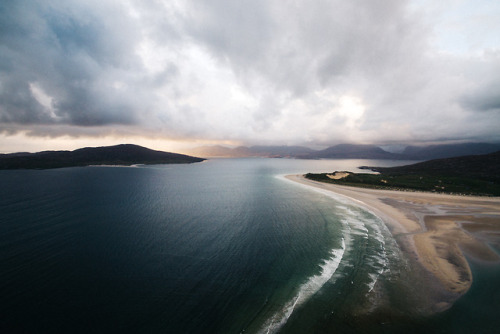#isle of harris
Blooming thistle in North Harris (Na Hearadh), Western Isles. Mèabhaig gu Bogha Glas.
Bogha Glas is a 11 miles path, one of the longest single paths in the Western Isles. The path takes you through one of the largest areas of wild land in Scotland along a centuries old path used by crofters, fishermen and deerstalkers. The first 5 miles follows a good level track through Glen Meavaig. The track is then replaced by a hill path which climbs two ridges and crosses a wide glen before dropping steadily back down towards Loch Seaforth.
Post link




Eilean Glas Lighthouse. Isle of Scalpay, UK

The Outer Hebrides are the last bastion of Sabbath observation in Scotland. As we cycled up from the southern cluster of islands, crossing onto Grimsay (island six of ten) and then North Uist (island seven), the dominant faith changed from Catholicism to the Calvinistic Free Church, who take the Sabbath very seriously.
Not a single shop, bakery or restaurant was open as we cycled through the last of the sea fret, which swirled around the mirror-smooth surface of the water. All the traffic was people in their Sunday best, making their way to church. No washing hung out to dry and no children played. Rumours still abound that people tie up playground swings to stop them being used.


We reached The Tractor Shed, accommodation in an adorable little wooden hut for two nights, which luckily was open. Storytelling Yorkshireman Duncan was our host. We settled in with a cup of tea and he told us about Hercules the trained grizzly bear, who was shipped over to the Outer Hebrides for a Kleenex advert in 1980 and went rogue (“he’d been watching too many nature documentaries”). He was on the run for 24 days before turning up, half starved, near someone’s croft. “Catching salmon is harder than it looks,” said Duncan.
Under the eaves of our hut was a deck and a little burner. M got a peat fire going in the evening light and we huddled around it as a legitimate hoolie began to blow. The wind howled all night and all of the next day. Two sets of frozen cycle tourists turned up, the first we’d seen going our way since we got off the ferry on Barra, and we swapped stories in the kitchen.

When it came our turn to leave, the wind was still whipping. At first it was a vicious, bullying crosswind, trying to shove us into the sinking peat bogs beside the road. Pouring rain came for good measure, and then the wind turned completely so we were pushing against it like it was solid. Every time I thought we were going to crest a hill and see the causeway to Berneray (island eight) laid out for us, there was yet another hill to be crested.
Finally we could see the grey water and the orange display board saying the ferries were all cancelled for the day. The tiny terminal had nothing but a hard wooden bench, but at least it was indoors. We took our waterproofs off to drip-dry and watched the energy-generating windmill outside trying to wrench from its concrete foundations, spinning so fast it was a blur.

Berneray’s little shop and bistro was just around the corner, so we braved it on foot to get some hot food. In the carpark was a Forecasting Stone. STONE IS WET: RAINING said the sign. SWINGING STONE: WINDY. STONE GONE: TORNADO. It didn’t feel far off.
The storm blew itself out and dawn came blue and gold and gorgeous. Just after sunrise we got on the ferry to Leverburgh. In 2006 this crossing had invoked fury amongst the islanders, and even a legal challenge, when operators CalMac added a Sunday sailing. An article from the time describes the ferry docking to posters that read “Remember the Sabbath Day to keep it Holy” but no protesters – that would have broken the Sabbath. There was no welcoming committee for us on Harris either (island nine!) but there was sunshine, which I would take any day.


Read the next Island Hopping blog: Hunting eagles on Harris


